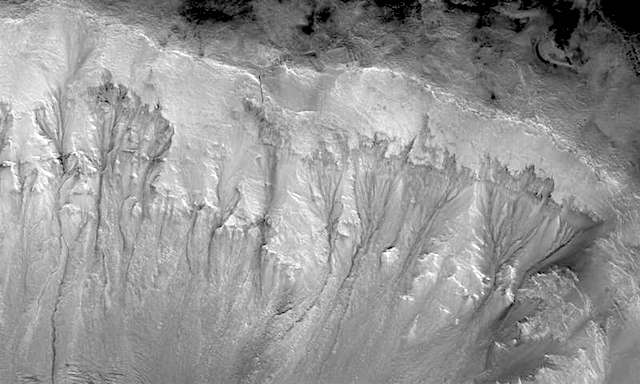 In mid-2018, researchers supported by the Italian Space Agency detected the presence of a deep-water lake on Mars under its south polar ice caps. [Ed. note: previously reported here.] Now researchers at the USC Arid Climate and Water Research Center (AWARE) have published a study [in Nature Geoscience] that suggests deep groundwater could still be active on Mars and could originate surface streams in some near-equatorial areas on Mars.
In mid-2018, researchers supported by the Italian Space Agency detected the presence of a deep-water lake on Mars under its south polar ice caps. [Ed. note: previously reported here.] Now researchers at the USC Arid Climate and Water Research Center (AWARE) have published a study [in Nature Geoscience] that suggests deep groundwater could still be active on Mars and could originate surface streams in some near-equatorial areas on Mars.
The researchers at USC have determined that groundwater likely exists in a broader geographical area than just the poles of Mars and that there is an active system, as deep as 750 meters, from which groundwater comes to the surface through cracks in the specific craters they analyzed.
Heggy, who is a member of the Mars Express Sounding radar experiment MARSIS probing Mars subsurface, and co-author Abotalib Z. Abotalib, a postdoctoral research associate at USC, studied the characteristics of Mars Recurrent Slope Linea, which are akin to dried, short streams of water that appear on some crater walls on Mars.
Scientists previously thought these features were affiliated with surface water flow or close subsurface water flow, says Heggy.
“We suggest that this may not be true. We propose an alternative hypothesis that they originate from a deep pressurized groundwater source which comes to the surface moving upward along ground cracks,” Heggy says.
“The experience we gained from our research in desert hydrology was the cornerstone in reaching this conclusion. We have seen the same mechanisms in the North African Sahara and in the Arabian Peninsula, and it helped us explore the same mechanism on Mars,” said Abotalib Z. Abotalib, the paper’s first author.
The two scientists concluded that fractures within some of Mars’ craters, enabled water springs to rise up to the surface as a result of pressure deep below. These springs leaked onto the surface, generating the sharp and distinct linear features found on the walls of these craters. The scientists also provide an explanation on how these water features fluctuate with seasonality on Mars… [More at links]








